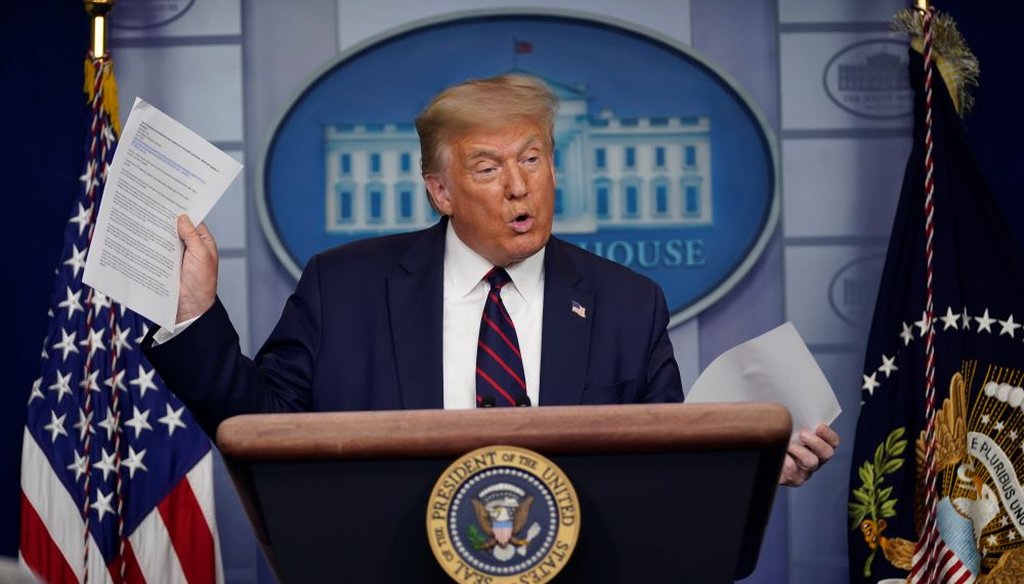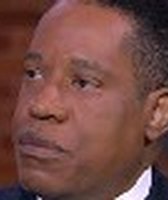Stand up for the facts!
Our only agenda is to publish the truth so you can be an informed participant in democracy.
We need your help.
I would like to contribute

President Donald Trump holds articles as he speaks during a news conference at the White House, Thursday, July 30, 2020, in Washington. (AP Photo/Evan Vucci)
If Your Time is short
-
President Trump has repeatedly drawn what election experts say is a false distinction between ‘absentee’ and ‘mail-in’ voting.
-
Experts say the safeguards and verification process for both are the same.
-
For decades, people have been allowed to request absentee ballots if they were sick, disabled or traveling during the election so they could cast their vote by mail.
-
A majority of states, however, no longer require voters to submit a reason to request an absentee ballot, a term that’s been phased out in many states, including California, in favor of ‘mail-in’ voting or ‘vote-by-mail.’
President Donald Trump on Thursday repeated what election experts across the United States say is a false distinction between "absentee" and "mail-in" voting, one that experts say threatens to sow confusion and undermine confidence in this fall’s election results.
In a tweet that grabbed the nation’s attention — mostly because Trump suggested postponing the Nov. 3 election (something only Congress can do) — the president also claimed absentee voting is "good," while again making the false assertion that mail-in voting is "fraudulent."
What Is Absentee Voting?
For decades, people have been allowed to request absentee ballots if they were sick, disabled or were traveling during the election so they could cast their vote by mail. A majority of states, however, no longer require voters to submit a reason to request an absentee ballot. The term has been phased out in many states, including California, in favor of "mail-in" voting or "vote-by-mail."
In a recent article, Factcheck.org found Trump, who voted by mail himself in 2018 and again in this year’s primary, has on numerous occasions said absentee voting includes stronger safeguards and verification.
Elections experts from California to Colorado to Florida told us that’s simply not the case.
"There’s really no distinction," said Darren Hutchinson, a law professor at the University of Florida and an elections expert, reacting to Trump’s effort to draw a line between absentee and mail-in voting. "So, it’s basically a falsehood that’s been repeated over and over and over again."
There are 34 states plus Washington, D.C. that offer what’s called "no excuse" absentee voting, also simply called mail-in voting, according to the National Conference of State Legislatures. Under that system, voters do not need to attest that they will be out of the voting jurisdiction on election day, or that they cannot get to the polls because of an illness or disability.
There is no special process that absentee out-of-town voters go through that other mail-in voters do not, Hutchinson said.
There are eight states, including Texas, Indiana and New York, where in-person voting "remains the only option unless people can provide an approved reason not related to fear of the coronavirus," according to The Washington Post.
Hutchinson said elections officials in these states simply check to ensure an approved excuse is listed on the form, but do not verify those excuses.
‘Fundamentally, it’s the same thing’
Election experts said the same safeguards and verification process apply to all methods of voting. To register, a voter must be a citizen of that state and be of voting age.
"Fundamentally, it’s the same thing," said Amber McReynolds, Denver’s former director of elections and chief executive officer of the National Vote at Home Institute. "Ballots are handled exactly the same regardless of whether or not it's an absentee ballot or a vote-by-mail ballot."
Jessica Levinson, an elections expert at Loyola Law School in Los Angeles, called Trump’s effort to draw a line between absentee and mail-in voting "a largely false distinction."
"It is not the case that there is one bucket of absentee balloting that is much safer, and then vote-by-mail just lacks all integrity, or vice versa," she said.
Levinson added that some of the confusion over the terms absentee and mail-in voting is generational. In California, election officials are phasing out the term absentee, but it was commonly used within recent decades. Whether someone uses it "is really more of an indication of when you started applying to vote-by-mail."
Also in California, Gov. Gavin Newsom signed a law in June requiring counties to send all active registered voters a mail-in ballot about a month before the Nov. 3 election.
Newsom said the move was necessary so that people would not have to risk their health by voting at polling places amid the COVID-19 pandemic. California will also provide some in-person voting options.
Six other states plus Washington D.C. plan to automatically send mail-in ballots to voters. Many other states allow voters to request those ballots.
Sam Mahood, spokesman for the California Secretary of State’s Office, agreed there’s no distinction between absentee and mail-in voting.
"We essentially do not use the term ‘absentee’ anymore in California," Mahood wrote in an email.
Hutchinson, the Florida law professor, said the president should be well aware that absentee and mail-in voting are now essentially the same thing.
As for why Trump continues to make this false distinction, Hutchison suggested the president "is trying to create uncertainty about the outcome" of the Nov. 3 election.
"It’s just a way of having people question the outcome if he loses," he said.
Related:
No, California Is Not Sending Mail-In Ballots "To Anyone In The State," As Trump Falsely Claimed
How Early Should You Send In Your Mail-in Ballot To Make Sure It Gets Counted? It Varies By State
Answering Questions About Vote-By-Mail In California Amid COVID-19, Attacks By Trump
CapRadio and PolitiFact California will continue answering questions about vote-by-mail and fact-checking similar topics through the November 2020 election. Email us your questions at [email protected], or contact us on Twitter or Facebook.
Our Sources
President Donald Trump, tweet, July 30, 2020
Jessica Levinson, professor, Loyola Law School, phone interview July 30, 2020
Darren Hutchinson, law professor, University of Florida, video interview July 30, 2020
Amber McReynolds, chief executive officer, National Vote At Home Institute, July 29, 2020
FactCheck.org, Trump’s Absentee vs. Mail-In Ballot Spin, June 19, 2020
NPR, Trump Repeats Unfounded Claims About Mail-In Voting, Threatens Funding To 2 States, May 20, 2020
The Washington Post, 16 Trump officials who have voted by mail recently, despite Trump’s warnings about it, June 23, 2020
PolitiFact California, No, California Is Not Sending Mail-In Ballots "To Anyone In The State," As Trump Falsely Claimed, May 26, 2020
PolitiFact California, How Early Should You Send In Your Mail-in Ballot To Make Sure It Gets Counted? It Varies By State, July 29, 2020
PolitiFact California, Answering Questions About Vote-By-Mail In California Amid COVID-19, Attacks By Trump, June 2, 2020




















































